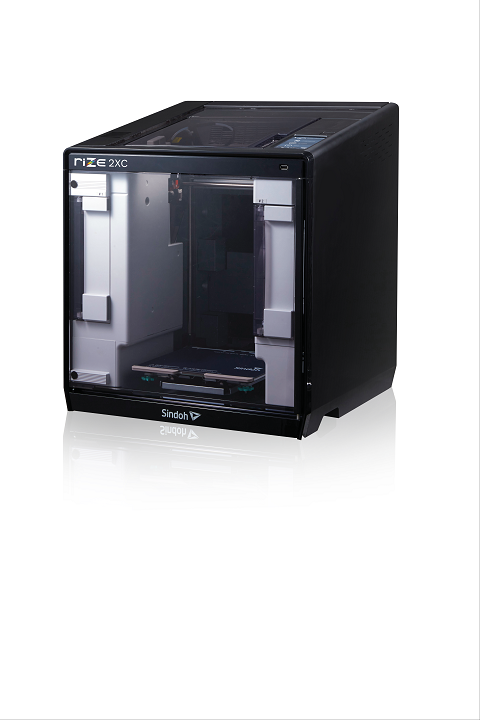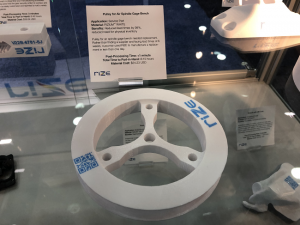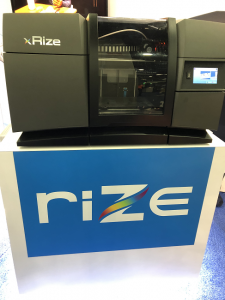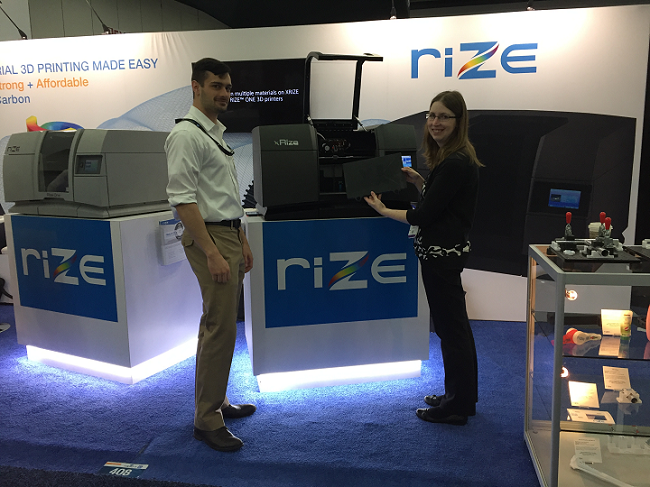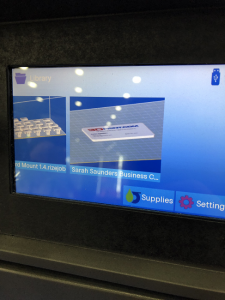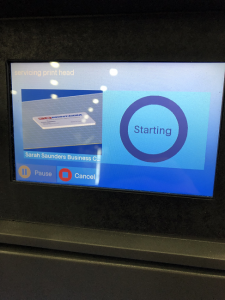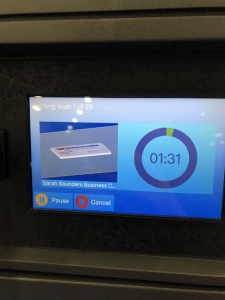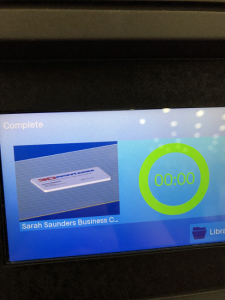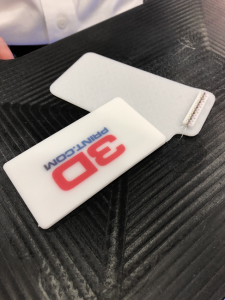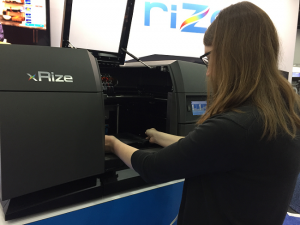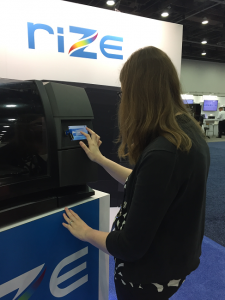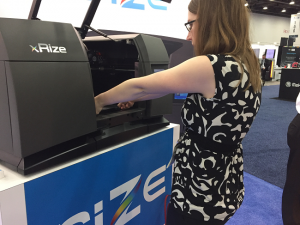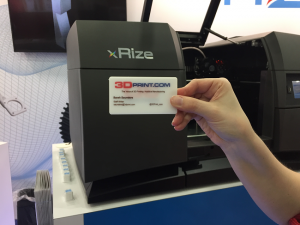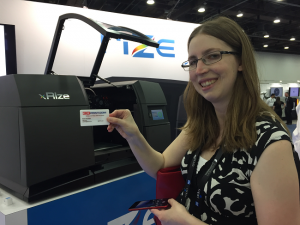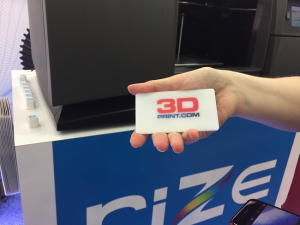RIZE Introduces Adaptive 2XC Desktop 3D Printer for Offices, Schools, and Homes
In 2016, Massachusetts-based 3D printing company RIZE Inc. released its first industrial-grade desktop 3D printer, the Rize One, renowned for its safety, low emissions, and elimination of post-processing. Then, in 2018, the company introduced the first industrial desktop AM solution for manufacturing full-color functional parts, the XRIZE system, which I was lucky enough to test out at RAPID 2019. Today, it’s announcing a new kind of desktop 3D printer, the professional RIZE 2XC, an adaptive system that was developed collaboratively with South Korean 3D printer manufacturer Sindoh.
 I spoke with RIZE CEO Andy Kalambi ahead of the release, who told me that even during the ongoing COVID-19 pandemic, the company has been “very productive.”
I spoke with RIZE CEO Andy Kalambi ahead of the release, who told me that even during the ongoing COVID-19 pandemic, the company has been “very productive.”
“It’s been an interesting time, but rewarding,” Kalambi said.
He said that the RIZE team speaks every morning during a check-in meeting, to make sure everyone is doing okay and see if anyone needs help with a project. Even during lockdowns across the US, the company has been busy, 3D printing personalized face shields that were distributed to hundreds of essential and healthcare works in the Boston area and working on the new 2XC.
“Entirely during COVID times, we developed this new printer with Sindoh,” he told me.
The RIZE 2XC was engineered from home offices, and, according to a RIZE press release, is a testament “to the safety principles embodied in RIZE’s solutions – principles that are especially relevant today as organizations reinvent workflows for a return to office locations.” The business supply chain needs to be even more flexible now due to COVID, and RIZE says its new printer can help. The 2XC can be used at home – no need to worry about germs spreading from lack of social distancing – and in offices and classrooms, with no fear of releasing harmful airborne volatile organic compounds (VOCs).
“The newer, higher performance, safe materials from next-gen FFF players such as RIZE are helping to drive a transformation in the 3D printing sector that are particularly relevant now as the world emerges from a pandemic. The durability and safety advantage that’s possible from next-generation 3D printing systems merits the attention of any engineering or design team that wants to give their users the best, and safest, tools,” Tim Greene, research director, 3D printing, for IDC said in the release.
The adaptive printer is the first deliverable to come from the RIZIUM Alliance, which is a new collaboration between RIZE and industry partners, like Sindoh, to drive safer, more sustainable 3D printing. The RIZE 2XC was made with a redesigned Sindoh dual-extrusion 3D printer, which can run engineering-grade RIZIUM materials that are moisture-resistant, recyclable, and zero emission.
 RIZIUM One material
RIZIUM One material“We based our material on safety – it’s engineered for safety, durability, and strength,” Kalambi told me. “They’re medical grade, and especially in today’s context, things like sanitizing and being able to wash it with alcohol or acetone is important. Materials science is our differentiating factor.”
Kalambi told me that the ‘C’ in the company’s new 2XC printer stands for ‘composite,’ since RIZE takes a “material-led approach.”
“What we have done now is taken our material portfolio and partnered with industrial players, so we can offer it to a broader market of users.”
Sindoh is applying the innovative RIZIUM materials, engineered for user health, so that customers in various sectors on its platform can use a safe, sustainable material at a lower price.
“With Sindoh, we’re working with the same materials,” Kalambi explained. “We have done lots of engineering efforts with them to get the printer ready for our materials, worked on nozzles and the drive train and the slicer, all of that, and made the printer far more robust. It’s a printer that is a joint product. It’s a new hybrid platform, releasing a set of products with Sindoh that’s based on our polymers and materials science.”
The two independent extruders on the RIZE 2XC are designed for composite filaments and hardened materials. One extruder runs RIZIUM polymers and composites, which can be washed with just soap and water, while the other runs the unique RIZIUM Support, created by RIZE specifically for filament-based extrusion 3D printers. All in all, RIZE says that its new printer offers a safe way to fabricate durable, strong, functional components, without any unnecessary post-processing.
“The RIZE 2XC is especially well-suited for a variety of Industrial and Academic applications,” Ricco Busk, Director at RIZE partner CADSYS, stated. “Given the high demand for having 3D Composite Parts, we are able to, almost immediately, sign up a customer for the RIZE 2XC to use in their innovative plastic molding applications, such as robotic grippers. Combining RIZE’s material advantage in the high quality, easy to use 2XC 3D platform opens doors to new markets for 3D printing that need precision parts made safely and sustainably.”
Kalambi told me that the RIZE 2XC has plenty of great features, such as a heated build plate, a camera for monitoring prints, and automatic bed leveling. Because the company’s Augmented Polymer Deposition (APD) platform has not been added, the system does not print in color, but he said that it does have “a much bigger build volume” in comparison to other desktop printers.
“It’s great for home and office use, as those industries wanted a good printer within a certain price point,” Kalambi explained. “Lots of 3D printing is being done in schools and offices, which is why we partnered with Sindoh…they have lots of knowledge in the education field. That industry had a requirement for a low-cost printer, and RIZE wanted to be able to offer a more affordable option.”
Kalambi also said that the RIZE 2XC is great for 3D printing industrial parts.
According to the RIZE release, this new printer is the first that has brought “safe, sustainable 3D printing” to the industry’s compact sub-$5k market, which can help organizations struggling to get back on their feet in a post-pandemic world get a leg up over the competition.
“Sindoh’s cooperative R&D effort with RIZE showed us that we chose the right partner indeed – a partner as committed to innovation in materials and technologies as we are. We’re delighted to expand our reach into more segments of the market through the cooperative solutions we are creating with RIZE,” said BB Lee, CEO, 3D Printing Division at Sindoh Co., Ltd.
The RIZE 2XC will be available from RIZE’s network of channel partners starting June 30th, for an introductory price of $3,995 in the US market and €3,995 in Europe. In the meantime, I’ll be keeping my ear to the ground, because Kalambi said RIZE will have some more exciting news to share with us in mid-July.
The post RIZE Introduces Adaptive 2XC Desktop 3D Printer for Offices, Schools, and Homes appeared first on 3DPrint.com | The Voice of 3D Printing / Additive Manufacturing.
3D Printing Industry News SLICED: Rize, 3D Systems, Essentium, Protect3d, Xioneer Systems
Interview with RIZE: Trying Out the XRIZE 3D Printer at RAPID 2019
[Image: Julie Reece, RIZE]
Typically, when I attend trade shows and events like RAPID + TCT and SOLIDWORKS World, I attend some presentations, maybe sit in on a panel discussion or two, and walk the show floor, conducting interviews and seeing what there is to see. I take closer looks at the systems we write about every day, get the chance to handle a part or two, and sometimes even try on 3D printed helmets. But I don’t normally have the opportunity to actually operate the hardware…until the recent RAPID 2019, when I met with Boston-based additive manufacturing company RIZE.
Let me back up – I was there for an interview with RIZE President and CEO Andy Kalambi to discuss the company’s patented Augmented Polymer Deposition (APD) technology, which allows for the easy snap-off release of supports. At formnext in November, the company introduced its industrial desktop XRIZE 3D printer, and I wanted to get a good look at the system that promises to print parts twice as fast as other leading AM technologies.
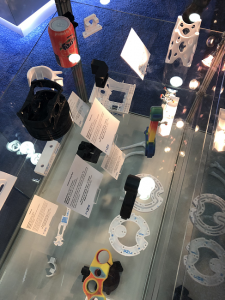 First, Kalambi told me that the company had just announced a partnership with Wichita State University’s National Institute of Aerospace Research (NIAR) at RAPID that’s focused on bringing 3D printing to end users.
First, Kalambi told me that the company had just announced a partnership with Wichita State University’s National Institute of Aerospace Research (NIAR) at RAPID that’s focused on bringing 3D printing to end users.
“We launched this whole concept called ‘smart spaces,’” Kalambi explained. “Makerspaces need to come to engineers, engineers don’t need to go to makerspaces.”
He told me that RIZE and its 3D printers are “purpose built” for safety, which is an area the company will not compromise on – this year, RIZE actually won the New Equipment Digest Innovation Award (the only 3D printing company to do so), and the Frost & Sullivan award for Best Practices in Technology Innovation, for its safe, zero-emission polymer 3D printing technology. In fact, Kalambi shared that a customer had told them at the AMUG conference that he uses their printers because he knows in 30 years he won’t get cancer – quite the endorsement.
“So we said, let’s purpose build our machine and our system for safety. Then we start extending that, and from safety we extend that to security – how do we ensure that a print is secure? That’s where the marking came in. And then we said, let’s start looking at applications and start solving those application problems. So that’s how we introduced carbon composite – this is another original material that has good strength.”
Engineering-grade RIZIUM CARBON is the company’s newest material, and features a higher modulus and excellent visual finish, making it perfect for functional prototyping.
Going back to the safe spaces concept, RIZE wanted to see what else they could add – more materials for more applications, and color as well.
“The 3D printing industry has condemned users to a monochrome world. So let’s bring color – every part can be in different colors, and not color for the sake of color, but color for the sake of communication, color for the sake of reducing errors, color for the sake of being more lifelike,” Kalambi said. “This is consumer validation…when you’re waiting at a traffic light and you see red, that’s communication.
“I don’t think this industry has bothered about color.”
 I mentioned there were only a few companies I could think of off the top of my head that were really doing color well, and he agreed, but stated that they were all really costly machines. Kalambi hopes that the next time we see RIZE machines displayed at a conference, all of the sample parts will be in color, and not just a few.
I mentioned there were only a few companies I could think of off the top of my head that were really doing color well, and he agreed, but stated that they were all really costly machines. Kalambi hopes that the next time we see RIZE machines displayed at a conference, all of the sample parts will be in color, and not just a few.
“There are many difference aspects to color, and that’s really exploded our use case scenarios.”
The company’s new color 3D printer will be heading to the market soon, shipping to early customers this month and generally available for purchase in August.
After mentioning that RIZE’s recent strategic partnership with Dassault Systèmes has brought the company a lot of continuity, we moved on to generative design and the company’s unique digitally augmented parts. He showed me how easy it was to add the company’s logo to the design file, as well as the bar code.
“Our uniqueness is our ability to mark,” Kalambi told me. “We’re the only ones doing it.”
Kalambi explained that RIZE covers the entire stream, all the way from digital marketing and quoting to manufacturing and delivery.
“You’re investing in the platform, not just the 3D printer,” he said. “We are focused on the user, not just the product.”
He said that RIZE wants users to feel comfortable using its machines and software, and that the company can train customers on its 3D printers in just 15 minutes. That’s when he got an idea – let me print something on the XRIZE at RAPID. Kalambi called over Vice President of Marketing Julie Reece to see if we’d have time to make it happen the next day, and once we figured out timing, he asked for my business card so it could be turned into a 3D model. Feeling pretty excited over what was to come, I left to conduct my next interview, with RIZE newly on my schedule for the next morning.
[Image: Julie Reece, RIZE]
When I arrived the next morning, Reece introduced me to RIZE Applications Engineer Neil Foley, who gave me a quick rundown on how the XRIZE 3D printer works. He opened the side panel so I could see the colored inks inside, and explained that the print of my business card would have a total of 29 layers; the first five layers would be a raft. The white filament is a little translucent so that the colors really shine through.
With just a few simple instructions from Foley, I was able to put in the magnetized build plate, close the door, and easily navigate the 3D printer’s touchscreen to select, and start, the print. The touchscreen not only tells you how long the print will take, but what layer it’s currently printing, with options to pause or cancel if necessary.
 I stayed at the booth to watch the five layers of the raft, and the first layer of the print itself, but then had to leave to take care of a few things before driving home from the show later that day. During the time I was gone, Reece contacted me to let me know that the print was complete, and that I could come back to the booth anytime to remove it from the plate.
I stayed at the booth to watch the five layers of the raft, and the first layer of the print itself, but then had to leave to take care of a few things before driving home from the show later that day. During the time I was gone, Reece contacted me to let me know that the print was complete, and that I could come back to the booth anytime to remove it from the plate.
Once I arrived, I took a few pictures of my completed print, then opened the door and pulled out the build plate, This was a little tougher than I imagined, possibly due to the magnets, but more likely because I tend to be nervous when handling expensive machinery and was afraid to pull too hard.
I was supposed to remove the supports myself, which I was really excited about, but because the print was pretty thin, they came off almost immediately when Foley removed the raft. But, Reece brought me over a small part that had just come off the Rize One so I could remove those supports, and it truly is as easy as it looks – hardly any pressure is required to snap them off. As for the XRIZE itself, it is definitely a user-friendly system, and for an industrial machine, that’s pretty great news.
All in all, I had a good talk with Kalambi at RAPID, and was thrilled to be given the chance to operate the XRIZE 3D printer and make a 3D printed version of my business card, which now sits on my desk at home. Take a look below to see more pictures that RIZE’s Julie Reece took of me operating the printer at RAPID:
Discuss this story and other 3D printing topics at 3DPrintBoard.com or share your thoughts in the Facebook comments below.
[Images: Sarah Saunders unless otherwise noted]
RIZE partners with SOLIDWORKS reseller Instadesign Group
Merck becomes latest customer of RIZE ONE 3D printer
Expert Discussion Looks to the Future of 3D Printing, Supply Chain, Democratization
During the Additive Manufacturing Symposium at this week’s Science in the Age of Experience held in Boston, Dassault Systèmes brought together a well-curated group of industry experts to share a depth of experience and insights. With plenary session and breakout presentations targeting both broad and deep dives into applications and real-world adoption, attendees were treated to discussions focusing on progress and challenges as well as application-specific issues in industrial 3D printing.
A panel discussion closed out the engaging Additive Manufacturing Symposium plenary session, featuring a conversation moderated by Dassault Systèmes’ Subham Sett with
- Andy Kalambi, Rize
- Eduardo Barocio, Purdue
- Shawn Ehrstein, NIAR
- Thomas Marchand, Biomodex
- John Laureto, Renishaw
- Sean McCluskey, Joby Aviation
Sett began the chat by asking where 3D printing is going, turning first to Kalambi for the manufacturer’s perspective.
“The first way is the easiest: take what you’re doing in subtractive and design it for additive; that’s the low-hanging fruit. The real value is in what we’re hearing in this conference: reduce complexity, change the supply chain. How do you print the parts as close as possible to the point of consumption? We’re looking at a digital supply chain, and taking additive into that, driving business model innovation,” Kalambi said, highlighting the new partnership between Rize and Azoth for indirect supply focus. “That’s where the biggest value is.”
There is great value in bringing additive manufacturing into business strategies, but barriers to adoption remain. Sett asked McCluskey for his perspective regarding these. Tracing back to a “small history lesson” in mistrust in the industry following high-profile acquisitions and failures to deliver, McCluskey noted that there are “still remnants of mistrust today” that are negatively impacting potential adoption.
“The single biggest gap, the shortcoming that will interfere with getting to these goals is that information and innovation happening is isolated; because of that mistrust, it’s being hoarded,” he explained. “We need to bridge those gaps, to bring innovation to the public space to work on the same problems with the same information. Hoarding information — and I’m using hoarding as a negative, though it’s not necessarily; look at IP — but good or bad, it’s slowing us down.”
Another barrier, Ehrstein added, comes in the form of regulation. Particularly for highly regulated industries such as aerospace and medical, parts qualification is a major hurdle to overcome.
“Getting the FAA to accept 3D printed parts on a critical structure is important. We saw Airbus, and obviously we use these parts; people want to use these parts even more. Getting those processes developed is a barrier,” he said. “In addition, we’re facing supply chain issues. If it starts getting bigger, who’s going to be out there supplying? If it starts getting bigger, will we have the supply chain to do it? And where is the workforce coming from? Where are the people who know how to design for these processes, to run the machines?”
Also highly sensitive to qualification and regulation is the medical sector, as Marchand weighed in.
“Certification is important. Looking at ISO standards, at reaching consistent quality, it’s pretty challenging,” he said. “Certifications in the medical space are as complicated as the aviation market.”
In addition to these barriers, discussion touched on simulation as a driver for evolution of technology and for eventual certification, as Barocio noted, in many respects representing a journey that has just started. Continuing to look forward, Sett asked about new technologies, and Kalambi touched on 3D printing as a platform with three “stacks”: hardware, software, and materials.
“For hardware, we see more and more hybridization will happen. Singular technologies are not solving all the big problems; hybridization will be the only way to solve some of these problems,” Kalambi said. “In software, there is a need for us to move forward, to digitally connect. Looking at materials, in polymers alone there are 60,000 plastics in the world. Focus has to be about innovating on the material, to mimic as wide a spectrum as possible to address possible use cases. Innovation is happening at each of these three levels.”
In the face of this “boatload of new technology coming out,” Sett asked, is the workforce keeping up? How can it? What steps ahead are necessary?
Workforce is certainly a critical issue facing the growing additive manufacturing industry, as companies and professional organizations are well aware. Education and training are imperative to upskill the workforce and prepare the next generation of engineers and designers, along with every other personnel aspect of manufacturing, for these new technologies.
“Workforce is an issue throughout engineering anyway,” Ehrstein remarked, “and on top of that with the oncoming technology of additive manufacturing as it keeps advancing faster than software can keep up with, than people can keep up with, workforce will remain an issue.
“We’re not the only school focusing on workforce; high schools are focusing on additive and growing up with additive. Everyone’s aware of additive manufacturing coming up. I have students whose first thought is, ‘I can just go print it,’ and that’s something I had to get used to thinking and other engineers had to get used to thinking. The problem is, with new technologies coming out every day, with new companies coming out with new technologies: what is the student actually learning?”
He continued, noting that the specifics of what can be done on each machine vary between technologies and between different system models. In order to meet the needs of the industry, he said, we need to find out what the industry is doing on these machines, which poses an ongoing challenge. Progams are in place, including at the WSU-affiliated NIAR, and these are constantly evolving.
All of the changes in the shape of industry impact the broader supply chain as well, Sett noted, moving the conversation forward. The main issue here, McCluskey said, comes in terms of volume. With advanced technologies come advanced materials; McCluskey used the example of polypropylene, which is commercially available at about 71 cents per pound. In contrast, he pointed to the equivalent supply of resin for a Carbon system at “more like $71 per pound,” adding that it wasn’t a perfect compoarison, but helps to get the point across. There are not, he summed up, enough tier one suppliers to supply all these materials right now.
Kalambi additionally pointed to the supply chain issue of building in trust. While many companies are increasingly focusing on blockchain and other advanced solutions for ensuring that IP remains secure, there is certainly much more work to be done in this area. The fast-moving industrial 3D printing market requires more solutions, and needs them soon.
“Today has had a lot of bubble-popping moments,” McCluskey said. “Here’s topology optimization; it’s great, but let’s pop that bubble. A lot of these issues aren’t new — look at anisotropy. It’s the same issues. They take time, absolutely… and it’s the same problem we’ve had forever. We need to address this on a much faster time scale for this process. We have the tools to address them, it just takes time.”
To wrap up the conversation, Sett turned to a much-used term being bandied about in 3D printing: democratization.
3D printing is frequently said to be democratizing manufacturing, putting manufacturing capabilities in the hands of a broader potential user base and enabling more in terms of agility. He turned to each panelist to ask for their final thoughts on this topic. McCluskey began, looking at the issue philosophically.
“Did the internet democratize data, or did it make it harder to find the information we need?” he asked. “You can put 3D printers in everyone’s garage, but the limiting factor is still the democratization of information and how to use it. For me, the journey has been about finding the right balance — yes, there are all these holy grail things additive manufacturing offers… We need to look how to address it in the short- mid- and long-term.”
Ehrstein continued, touching on a popular misconception lingering around 3D printing.
“There’s a lot of thinking out there that you just set out your machine and press print, and boom. There are a lot of processes, there are a lot of machines, and it takes someone a year of experience before they can legitimately create consistently good parts on that machine. You have to make the investment on training, the investment on time and experience. If you’re a small company thinking about going additive, before you make that investment into these machines that can go into a million-plus dollars, I personally think you’re better off using the supply network out there first. See how the parts work, how much the parts work, before you make that investment,” he said. “There’s the thinking that when I have that machine I can just have him print that part out over there, and the truth is if you’re not running those machines every day, it takes some time before you get to that point.”
Laureto picked up from there, noting that at Renishaw, they constantly deal with the cost of entry as a barrier to adoption. This is of course not limited only to initial investment, but to continuing costs of operation.
“Economic analysis is needed,” he reaffirmed. “Do all that work up front. Try to work with everyone to find that type of solution. Because not only do you buy that machine, you fill it with $60,000 worth of titanium monthly.”
Another barrier stands in the way of the typical requirements for industrial machinery, including safety equipment, proper ventilation, and the necessary physical footprint. Kalambi addressed this issue from the perspective of an industrial desktop 3D printer manufacturer known for its ease of use and environmental friendliness.
“That question is why we’re in business: to democratize, to take industrial additive manufacturing to where it has not been before. I have seen that this business has not scaled because of this question,” he said. “Working with masks and gloves limits who can go there, and this limits adoption. We have a machine that requires no venting, and can run safely on the floor here; we believe that it should be like what was mentioned here, pervasive enough that people can set up microfactories. This is where 3D printing has to go.”
Turning to the medical sector, we see that issues are a bit more specialized. Speaking to the life science point of view, Marchand noted that hospitals have a huge need, as 3D printing can be applied to synthetic organs, to prostheses, and more.
“Every hospital would like to have a 3D printing lab, and some do. The thing is, it’s painful to have a 3D printing lab. We know that because we have two, one in the US, and one in France,” he said. “We had to go to market this way, and had no one to help us this way, to manufacture up to standards all the time. We are seeing democratization of 3D printing in hospitals, but many machines right now are not very reliable, post-processing is a problem, and you need the right people. There are still many problems to tackle.”
Barocio had the final word in the discussion of democratization, and took the opportunity to offer some advice.
“My recommendation for the additive manufacturing journey is: simulation could be a heavy investment, and something in the long term will help to come up to speed faster, also lowering the costs of trials and errors,” he said. “I really recommend to use simulation, not only hardware.”
The overall tone of the discussion remained conversational, as these various perspectives came together to offer a quick picture of a fast-growing industry and technology still enduring its growing pains. The points raised offered plenty of food for thought — among many great minds in hardware, software, materials, and end-use applications set to continue driving advances apace.
Discuss Dassault Systèmes, industry challenges, and other 3D printing topics at 3DPrintBoard.com or share your thoughts in the Facebook comments below.
[All photos: Sarah Goehrke]


